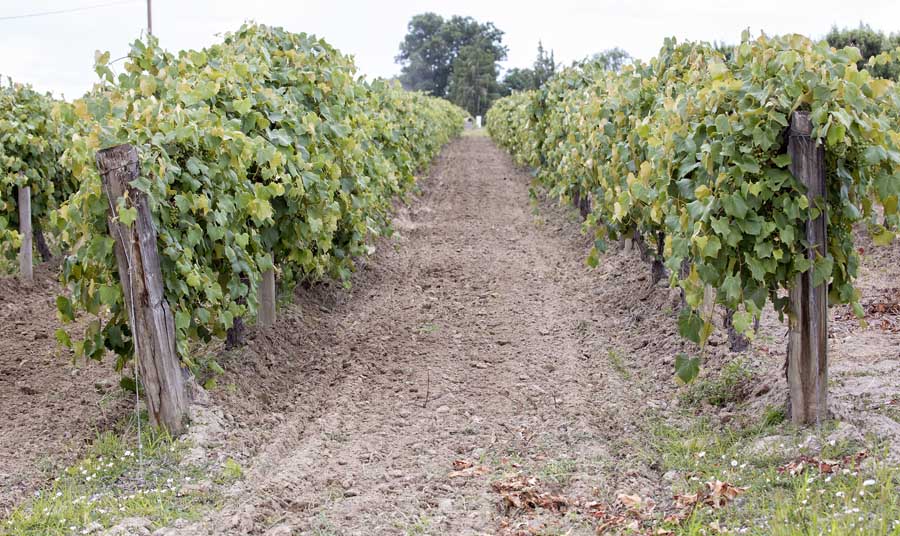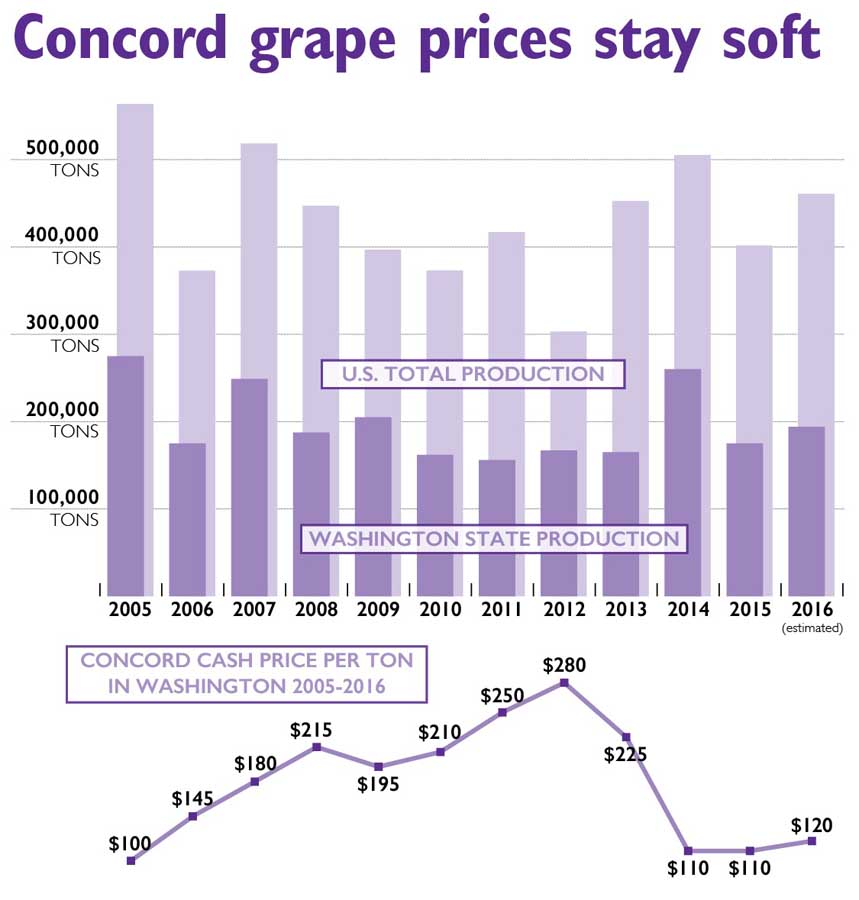
Concord grapes grow near Sunnyside, Washington, in mid-June last year. Washington is the largest Concord juice grape producer in the nation, with about 42 percent of the total U.S. crop. TJ Mullinax/Good Fruit Grower
A third straight year of low prices awaits Concord grape growers after the 2016 harvest.
Thus, just like the previous year, industry experts expect farmers to continue removing acreage as they try to push demand and prices higher. However, don’t expect any quick improvements.
“There are trends that are looking like things will start to slowly pick up, but it’s not going to be a quick correction going into next year,” consultant Trent Ball said at the annual meeting of the Washington Grape Society in mid-November in Grandview, Washington.
Ball, an agriculture instructor at Yakima Valley College, has been invited by the Grape Society to give growers an industry snapshot of wine and juice grapes at the annual meeting since 2007, a presentation sometimes called the “State of the Grapes.”
Productivity-wise, growers all over the country had it pretty good.
In Washington, above-average yields left growers expecting to harvest 194,000 tons this year, Ball said.

Concord growers won’t see much relief from low prices after the total U.S. crop is expected to top 400,000 tons for a fourth straight year. Source: USDA Jared Johnson/Good Fruit Grower
That’s well above last year’s drought-hampered crop, though just below the 10-year average. Washington is the nation’s leading Concord juice grape producer, representing about 42 percent of U.S. production.
Other U.S. growing regions — Michigan, New York and Pennsylvania — also expect large crops, putting the nation’s tonnage at about 461,000 tons, the fourth largest in the past 12 years.
New York, the nation’s second largest Concord producer, anticipated a harvest of 137,000 tons, way above its average of 117,000 tons.
Add in Pennsylvania and the entire Lake Erie region expected 208,000 tons, exceeding last year’s 172,000-ton total for the two states.
Meanwhile, Michigan expected a crop of 60,000 tons, 50 percent above the average of 40,000 tons and the state’s third above-average crop in a row.
“It’s another big production for the East region,” Ball said. That’s despite some drought worries earlier in the year and fall rains that threatened Brix levels in some places.
All those big numbers are the problem for prices.
The large national crop only adds to inventories of juice concentrate that continue to languish in storage, keeping prices low for growers bringing grapes to the processor.
In 2016, cash prices for Washington growers inched up from $110 to $120 per ton, though they remain in a down cycle far below the 2012 spike of $280, Ball said.
Cash prices in the Eastern regions were about the same as Washington this year, falling from about $160 in 2015.
Even imports have slowed in recent years due to oversupply and Americans’ overall declining taste for juice.
In 2015, the United States imported 45.8 million gallons, down from 78.9 million gallons in in 2007.
Those imports compete directly with U.S. stocks. About 80 percent of imports come from Argentina.
In reaction to the oversupply, growers have been pulling out Concord grapes, a trend Ball expects to continue, which he in turn expects to nudge prices up. “Next year I hope to come back with really awesome news,” he quipped. “I’ll try my best.”
Washington acreage has dropped by more than 20 percent since 2007 to a current estimated 18,760 acres, with growers pulling out vines to replace with hops, wine grapes or fruit trees.
From discussions with processors, Ball anticipates Washington growers will remove between 200 and 400 more acres before next season. He does not expect growers to add any acreage for some time.
Sunnyside’s Art den Hoed is among those removing vines.
Over the course of four years, den Hoed plans to have removed about 200 acres of Concord grapes, more than half his total, replacing them with cherries and Pink Lady and Envy apples, both club varieties. He plans to leave some Concords in low, frost-prone spots.
“Ground’s too expensive to have a crop that doesn’t return,” he said. Den Hoed sends his grapes to two Washington processors, Valley Processing in Sunnyside and Welch’s in Grandview.
Ironically, he praised the 2016 Concord harvest for its yield, timing and tonnage. Early season warmth sped up the growth, later season rains did not affect sugar levels and he never had to worry about frost.
“It was a great year as far as the grapes go,” he said. •
– by Ross Courtney






Leave A Comment